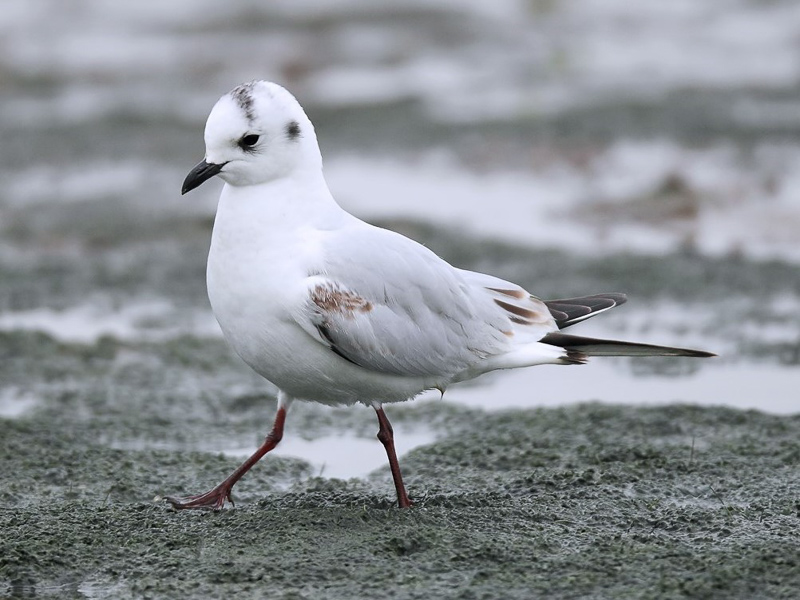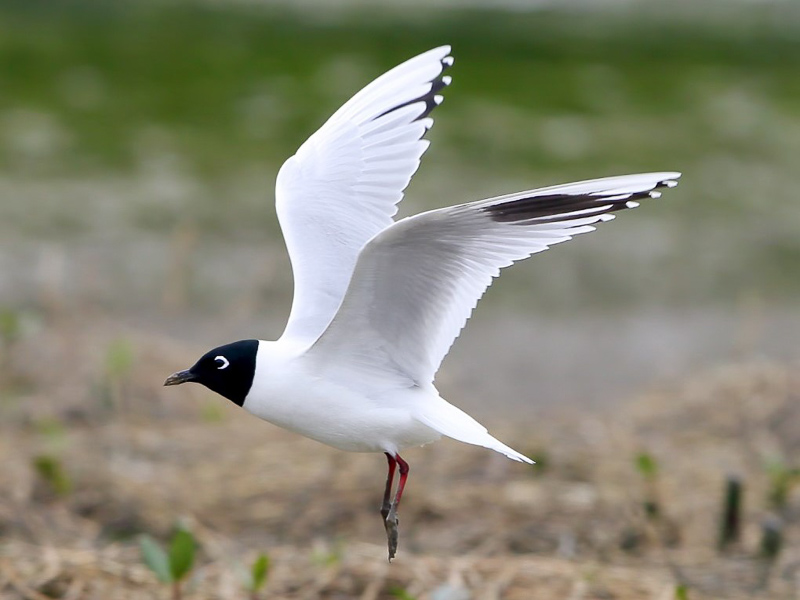Saunders’s Gull Saundersilarus saundersi 黑嘴鷗
Category I. Uncommon winter visitor to Deep Bay. Numbers have declined substantially since the mid-1990s.
IDENTIFICATION

Mar. 2011, Michelle and Peter Wong. Adult, breeding plumage.
29-32 cm. Slightly smaller than Black-headed Gull with a relatively short and thick bill. In breeding plumage has black head and nape with broad white crescents around much of the eye and broad white tips to black primaries.
Adult in non-breeding plumage has blackish spot behind the eye that extends diffusely to the crown, and a diffuse blackish band above eye over crown. The legs are deep red.

Jan. 2012, Michelle and Peter Wong. First-winter.
First-years have brown in the wing coverts, secondaries and inner primary tips, a brown tail band and dark outer primaries; all are rather faded on this bird.

Mar. 2014, Michelle and Peter Wong. Adult, breeding plumage.
In flight adult has white outermost primary and white tips to next three or four, with black subterminally. Black hood border is vertical when seen side on in flight.
VOCALISATIONS
Generally, rather tern-like.
DISTRIBUTION & HABITAT PREFERENCE
Almost exclusively occurs in the intertidal mudflats of Deep Bay, rarely coming to roost on Mai Po NR. There are only three records away from Deep Bay: single adults in the western part of Victoria Harbour on 17 March 1978 and at Chek Lap Kok on 17 March 1997, and five off Po Toi on 10 October 2017.
OCCURRENCE
Uncommon winter visitor and passage migrant in spring to intertidal areas of Deep Bay. Apart from an adult present from 5 September 2012 into October, the earliest arrival date is 10 October 2017 when, unusually, five were seen over the sea near Po Toi. In most years the first arrivals are noted in early November, though counts of 40 or higher are not made until the final week of the month.
Figure 1 illustrates the pattern of peak winter counts since 1985/86, when access to the intertidal mudflats of Deep Bay was possible via the boardwalk hide at Mai Po NR. During December to February from 1989/90 to 1997/98 the highest winter count was a minimum of 91 birds, usually over 100, with the highest being 172 on 10 February 1994. Since 1999/2000, however, the peak winter count has been lower than 75 apart from one winter period in which 114 were counted. The average peak count in the 1990s was 115, whereas the same figure for the period from winter 2010/11 was only 66. Population decline is one possible explanation for this (though the lack of surveys along the Chinese coast before 2005 makes it difficult to judge if a decline actually occurred), but milder winters allowing more birds to remain further north could also be a factor.
From about late January there usually begins an increase in numbers that is presumed to involve northbound migrants, though it possibly comprises birds from further north escaping cold weather. By early February the increase in numbers is conspicuous with many adults largely attaining the black hood of breeding plumage by the middle of the month.
The last week of February sees the beginning of a decline in numbers, and by late March any birds remaining are generally first-year birds. Very rare after the third week of April, the latest spring record occurred on 18 May 2011. In addition, an injured bird was present on 23 May 2007 and the only summer record is of one on 11 June 2008.
The first record for HK concerned two adults in breeding plumage at Mai Po on 14 March 1969. Recorded annually in Deep Bay subsequently, until 1974 the bulk of records fell between 18 February and 22 March, indicating that passage birds probably accounted for most sightings. From the winter of 1974-1975 Saunders’s Gulls wintered regularly in Deep Bay. Improved access to the mudflats since 1986 accounts at least in part for the increase in numbers subsequently.
BEHAVIOUR, FORAGING & DIET
Foraging occurs singly with birds flying over the intertidal mudflats before swooping down in the manner of Gull-billed Tern. Preys primarily on polychaete worms and small crabs.
At roost sites Saunders’s Gull remain scattered among the Black-headed Gull flock on the higher parts of the mudflat, rather than congregating together.
SYSTEMATICS & RANGE
Monotypic. Largely Chinese breeding endemic in coastal salt marsh around the Bay of Bohai and the Yellow Sea, wintering from South Korea and the Bay of Bohai south to Vietnam, as well as in southern Japan (Burger et al. 2020, Liu et al. 2007).
CONSERVATION STATUS
IUCN: VULNERABLE. Population thought to be decreasing, which is likely to become rapid due to reclamation of tidal flats and disturbance at colonies. Population size estimate: 14,400.
Figure 1.

Burger, J., M. Gochfeld, E. de Juana, E. F. J. Garcia, and G. M. Kirwan (2020). Saunders's Gull (Saundersilarus saundersi), version 1.0. In Birds of the World (J. del Hoyo, A. Elliott, J. Sargatal, D. A. Christie, and E. de Juana, Editors). Cornell Lab of Ornithology, Ithaca, NY, USA. https://doi.org/10.2173/bow.saugul2.01
Liu, Y., P. I. Holt and Zhang, Z. W. (2007). Wintering Records of Saunders’s Gull in Bohai Bay, China. J. Yamashina Inst. Ornithol. 38: 100-103.

